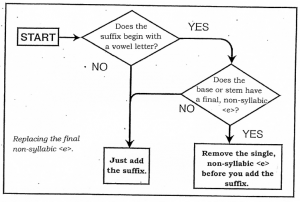I am always surprised when students new to fifth grade misspell words like makeing, comeing, and lazey. I’m surprised because they’ve been writing these words for many years. Obviously, they never understood whether to keep the <e> or to replace it when adding the suffix! I may be surprised, but I’m not particularly concerned. These are spelling errors I can help eliminate!
The following Suffix Flow Chart is borrowed with permission from Pete Bower’s book “Teaching How the Written Word Works”.

I made copies and had each student glue it in their Orthography notebook for future reference. To begin with, we read through the flow chart together. Someone read the first diamond. We imagined the answer was NO, and decided where we should go next. Then we went back and imagined the answer was YES, and followed the arrow to the next diamond. We kept reading and following arrows until we had read all the boxes in the flow chart. Now we were ready to practice using it.
I wrote the following word sum on the board:
smile + ing –>
Then I asked someone to read aloud the first question we must consider. Before that question was answered, we reviewed which morpheme was the base or stem and which was the suffix. They also wrote the vowel letters above the flow chart in their notebooks.
Now the question was read again and answered. “The suffix <-ing> begins with the vowel letter <i>, so the answer to the first question is YES.” We followed the arrow to the next diamond shape and read the question: Does the base or stem have a final, non-syllabic <e>? We looked at <smile> and agreed that the final <e> was indeed non-syllabic.
Then we followed the YES arrow to the final box where it said to remove the single, non-syllabic <e> before adding the suffix. At this point we crossed out the <e> at the end of <smile> and were ready to write the final spelling of the word.
Here is how the final word sum looked:
smile/ + ing –> smiling
Here is how the students practiced reading it:
“s-m-i-l-e plus i-n-g is rewritten as s-m-i-l NO e i-n-g”
When reading it aloud, the morphemes are spelled out. Always. The students recognize the absence of the letter <e> in the final spelling of the word by saying “NO e”, so that they are always cognizant of its place on the base or stem.
We went through a few more examples including the word sums “grate + ful” and “create + or”. Then I gave them each a list of word sums, had them glue it in their notebooks and let them practice using the Suffix Flow Chart independently.
Everyone got right to it. I would say that it took maybe three minutes before the questions began.
“I’m not sure about this one.”
“What is the first question to ask yourself on the flow chart?”
“Does the suffix begin with a vowel?”
“Well, does it?”
“Yes.”
“So where does the flow chart direct you to next?”
“Does the base or stem have a final non-syllabic <e>?”
“Does it?”
“Yes. But if I remove the <e>, the word doesn’t look right!”
Student after student said the same thing. And while I directed each one to a dictionary to check the spelling, I couldn’t help but notice a big problem. These students had been taught to judge whether a word was spelled correctly or not by whether or not it looked correct.
So I stopped the class and asked if my observation was accurate. In each of my three classes, 98% of the students said that they often wrote a word two or three different ways and then chose the spelling that looked correct.
So today I feel great. I gave them a more reliable option. Why not just rely on the simple rule beautifully laid out in the Suffix Flow Chart? No more guessing games. No more taking chances. A few less words to edit when getting ready to publish one’s writing. Who wouldn’t love it?

